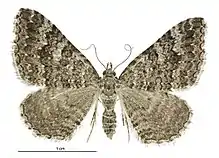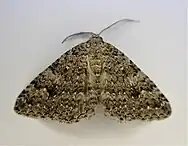| Helastia semisignata | |
|---|---|
 | |
| Female | |
 | |
| Male | |
| Scientific classification | |
| Domain: | Eukaryota |
| Kingdom: | Animalia |
| Phylum: | Arthropoda |
| Class: | Insecta |
| Order: | Lepidoptera |
| Family: | Geometridae |
| Genus: | Helastia |
| Species: | H. semisignata |
| Binomial name | |
| Helastia semisignata | |
| Synonyms[2][3] | |
| |
Helastia semisignata is a moth of the family Geometridae.[1] This species is endemic to New Zealand and is only found in the North Island. The life history of this species is in need of further investigation as sources differ about what plants host the larvae. Adults are on the wing commonly from October until March.
Taxonomy
It was first described by Francis Walker in 1862 using specimens collected by A. Sinclair in Auckland and originally named Larentia semisignata.[4][3][2] In 1877 Arthur Gardiner Butler synonymised Cidaria dissociate and Cidaria semisilata with L. semisignata.[5] In the same publication Butler also mistakenly synonymised Larentia corcularia with L. semisignata.[5] This taxonomic error was correct by R. C. Craw in 1987.[2] In 1912 L. B. Prout placed this species in the genus Xanthorhoe.[6] This placement was followed by George Hudson in his 1928 book The butterflies and moths of New Zealand.[7] Subsequently, in 1971, J. S. Dugdale placed this species in the genus Helastia.[8] R. C. Craw confirmed this placement in his revision of the genus in 1987.[2] The male holotype is held at the Natural History Museum, London.[3]
Description

Walker described this species as follows:
Cinereous, minutely black-speckled. Head wanting. Fore wings with several denticulated blackish lines, some of which are most conspicuous on the veins, where they form black points; middle space without lines, containing the black transverse elongated discal point; interior, exterior and submarginal lines formed by whitish points on the veins; marginal lunules black; costa convex; exterior border hardly convex. Hind wings paler, with indistinct lines. Length of the body 4 lines; of the wings 12 lines.[4]
Species in the genus Helastia can be difficult to distinguish from one another.[9] However this species normally has orange scaling present on its forewings and its wing veins have black and white patches.[9]
Distribution
This species is endemic to New Zealand.[1] It is found in the North Island only.[9]
Habitat
H. semisignata can be found in a variety of habitats at a variety of altitudes including native forest and scrubland, subalpine herbfields and in coastal areas.[9] This species also inhabits developed areas such as parks and gardens.[9]
Behaviour
Adults are on the wing from most frequently from October until March and are attracted to light.[9][10] They are nocturnal with adults resting on trees or stones during the day.[9]
Host plants

Larvae of this species have been raised on mosses.[9] But other sources state that larvae have been reared on Pimelea foliage or that they feed on herbs.[11][12] These inconsistencies have resulted in Robert Hoare stating that further investigations into the life history of this species is needed.[9] The adult moths have been observed visiting and likely feeding from the flowers of Hoheria lyallii, Olearia virgata andVeronica salicifolia.[13][14]
References
- 1 2 3 "Helastia semisignata (Walker, 1862)". www.nzor.org.nz. Retrieved 2022-04-27.
- 1 2 3 4 R. C. Craw (April 1987). "Revision of the genus Helastia sensu stricto with description of a new genus (Lepidoptera: Geometridae: Larentiinae)". New Zealand Journal of Zoology. 14 (2): 269–293. doi:10.1080/03014223.1987.10422997. ISSN 0301-4223. Wikidata Q54670161.
- 1 2 3 John Stewart Dugdale (23 September 1988). "Lepidoptera - annotated catalogue, and keys to family-group taxa". Fauna of New Zealand. Department of Scientific and Industrial Research. 14: 181. doi:10.7931/J2/FNZ.14. ISSN 0111-5383. Wikidata Q45083134.
- 1 2 Francis Walker (1862), List of the Specimens of Lepidopterous Insects in the Collection of the British Museum, XXIV: Geometrites (continued), vol. 24, p. 1200, Wikidata Q109609883
- 1 2 Arthur G. Butler (1877). "On two Collections of Heterocerous Lepidoptera from New Zealand, with descriptions of new Genera and Species". Journal of Zoology. 1877: 394. ISSN 1469-7998. Wikidata Q109479517.
- ↑ Louis Beethoven Prout (30 August 1911). "Notes on the nomenclature of the New Zealand Geometridae, with descriptions of a new species". Transactions and Proceedings of the New Zealand Institute. 44: 52. ISSN 1176-6158. Wikidata Q110727587.
- ↑ George Vernon Hudson (1928), The butterflies and moths of New Zealand, Illustrator: George Hudson, Wellington: Ferguson and Osborn Limited, p. 113, LCCN 88133764, OCLC 25449322, Wikidata Q58593286
- ↑ J. S. Dugdale (10 November 1971). "Entomology of the Aucklands and other islands south of New Zealand: Lepidoptera, excluding non-crambine Pyralidae" (PDF). Pacific Insects Monographs. 27: 101. ISSN 0078-7515. Wikidata Q64006453.
- 1 2 3 4 5 6 7 8 9 Robert J. B. Hoare (2014). A Photographic Guide to Moths & Butterflies of New Zealand. Illustrator: Olivier Jean-Philippe Ball. p. 96. ISBN 978-1-86966-399-5. Wikidata Q59396160.
- ↑ Peter G. McGregor; P. J. Watts; M. J. Esson (January 1987). "Light trap records from southern North Island hill country". New Zealand Entomologist. 10 (1): 104–121. doi:10.1080/00779962.1987.9722515. ISSN 0077-9962. Wikidata Q57483702.
- ↑ Brian H. Patrick (1994), Coastal butterflies and moths of Wellington and South Wairarapa. (PDF), Wikidata Q110426707, archived from the original (PDF) on 13 December 2021
- ↑ Ecological monitoring for Te Tumu Kaituna 7B2 Ecological restoration project, 2013 (Report). Wildlands Ltd. 2013.
- ↑ "Helastia semisignata (Walker, 1862)". plant-synz.landcareresearch.co.nz. Retrieved 2023-03-07.
- ↑ Richard B. Primack (July 1983). "Insect pollination in the New Zealand mountain flora". New Zealand Journal of Botany. 21 (3): 317–333. doi:10.1080/0028825X.1983.10428561. ISSN 0028-825X. Wikidata Q54669862.